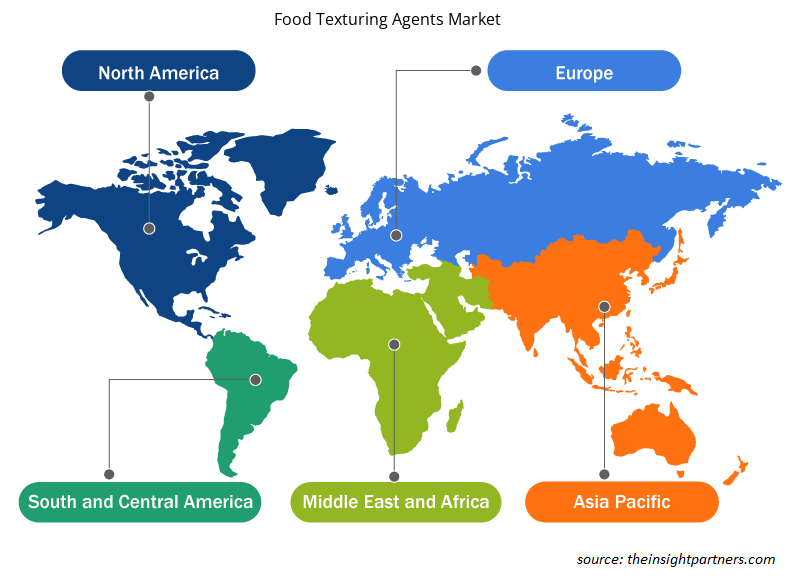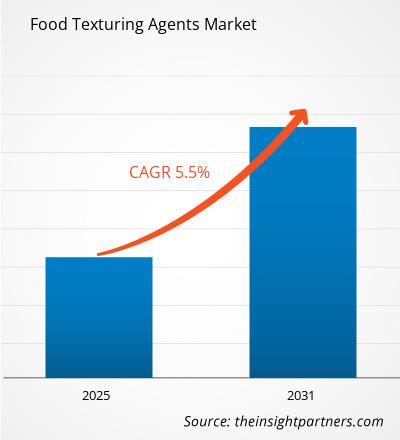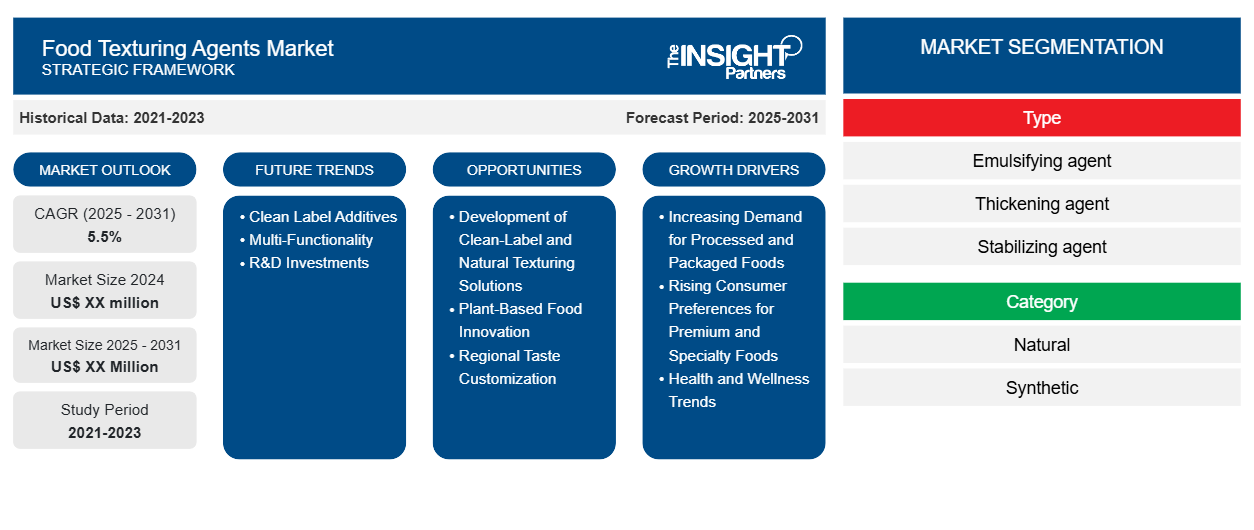Si prevede che il mercato degli agenti testurizzanti alimentari registrerà un CAGR del 5,5% dal 2024 al 2031, con una dimensione di mercato in espansione da XX milioni di dollari nel 2024 a XX milioni di dollari entro il 2031.
Il rapporto di mercato Food Texturing Agents copre l'analisi per tipo (agente emulsionante, agente addensante, agente stabilizzante, agente gelificante, altri); categoria (naturale, sintetico); applicazione (panetteria e dolciumi, carne, pollame e frutti di mare, salse e condimenti, bevande, cibi RTE e RTC, altri) e geografia (Nord America, Europa, Asia Pacifico e Sud e Centro America). L'analisi globale è ulteriormente suddivisa a livello regionale e nei principali paesi. Il rapporto offre il valore in USD per l'analisi e i segmenti di cui sopra.
Scopo del rapporto
Il report Food Texturing Agents Market di The Insight Partners mira a descrivere il panorama attuale e la crescita futura, i principali fattori trainanti, le sfide e le opportunità. Ciò fornirà spunti a vari stakeholder aziendali, come:
- Fornitori/produttori di tecnologia: per comprendere le dinamiche di mercato in evoluzione e conoscere le potenziali opportunità di crescita, consentendo loro di prendere decisioni strategiche informate.
- Investitori: condurre un'analisi completa delle tendenze relative al tasso di crescita del mercato, alle proiezioni finanziarie del mercato e alle opportunità esistenti lungo la catena del valore.
- Enti di regolamentazione: regolamentano le politiche e le attività di controllo sul mercato allo scopo di ridurre al minimo gli abusi, preservare la fiducia degli investitori e sostenere l'integrità e la stabilità del mercato.
Segmentazione del mercato degli agenti testurizzanti alimentari
Tipo
- Agente emulsionante
- Agente addensante
- Agente stabilizzante
- Agente gelificante
Categoria
- Naturale
- Sintetico
Applicazione
- Panetteria e pasticceria
- Carne
- Pollame e frutti di mare
- Salse e condimenti
- Bevande
- Cibi RTE e RTC
Geografia
- America del Nord
- Europa
- Asia-Pacifico
- America del Sud e Centro
- Medio Oriente e Africa
Personalizza questo report in base alle tue esigenze
Riceverai la personalizzazione gratuita di qualsiasi report, comprese parti di questo report, o analisi a livello nazionale, pacchetto dati Excel, oltre a usufruire di grandi offerte e sconti per start-up e università
- Scopri le principali tendenze di mercato in questo rapporto.Questo campione GRATUITO includerà analisi di dati che spaziano dalle tendenze di mercato alle stime e alle previsioni.
Fattori trainanti della crescita del mercato degli agenti testurizzanti alimentari
- Domanda crescente di alimenti trasformati e confezionati:
con l'aumento del consumo di alimenti trasformati e confezionati a livello globale, cresce anche la domanda di agenti texturizzanti per alimenti. Questi agenti vengono utilizzati per migliorare la consistenza, la consistenza e la sensazione al palato di prodotti alimentari come salse, latticini e prodotti da forno, rendendoli essenziali nella produzione alimentare. - Crescenti preferenze dei consumatori per cibi premium e speciali:
c'è una domanda crescente di cibi premium e speciali, tra cui prodotti alimentari biologici, senza glutine e funzionali. Gli agenti texturizzanti per alimenti svolgono un ruolo fondamentale nel migliorare le proprietà sensoriali di questi prodotti, portando al loro crescente utilizzo in categorie alimentari di fascia alta e di nicchia. - Tendenze per la salute e il benessere:
la crescente tendenza verso un'alimentazione più sana sta alimentando la domanda di agenti texturizzanti per alimenti che possano offrire benefici come un contenuto inferiore di grassi, zuccheri e calorie senza compromettere il gusto o la consistenza. Ingredienti come gli idrocolloidi, che forniscono una sostituzione di grassi o zuccheri, vengono sempre più utilizzati per soddisfare questa tendenza.
Tendenze future del mercato degli agenti testurizzanti alimentari
- Additivi Clean Label: la preferenza dei consumatori per la trasparenza spinge verso addensanti e stabilizzanti naturali come la pectina e la gomma di guar.
- Multifunzionalità: gli agenti testurizzanti sono diventati multifunzionali, dal miglioramento della sensazione in bocca alla stabilizzazione dell'emulsione, influenzando così le previsioni di mercato.
- Investimenti in R&S: i principali attori investono in miscele testurizzanti innovative, personalizzate per alimenti di origine vegetale, ottenendo così un vantaggio competitivo.
Opportunità di mercato per gli agenti testurizzanti alimentari
- Sviluppo di soluzioni di testurizzazione naturale e Clean-Label: la domanda di ingredienti Clean Label è in aumento poiché i consumatori preferiscono etichette più pulite. Ciò può quindi rappresentare un'opportunità per i produttori in termini di acquisizione di crescita poiché producono agenti testurizzanti alimentari naturali, in particolare agenti testurizzanti vegetali o biologici che rispettano queste tendenze attente alla salute principalmente in Nord America ed Europa.
- Innovazione alimentare a base vegetale: c'è una richiesta di agenti texturizzante che imitano la consistenza di carne, latticini e altri prodotti di origine animale negli alimenti a base vegetale. La tendenza apre un'opportunità per i produttori di innovare e conquistare quote di mercato nel segmento a base vegetale.
- Personalizzazione del gusto regionale: aree geografiche come l'Asia-Pacifico con una forte diversità culinaria offrono opportunità ai produttori che possono offrire agenti di testurizzazione personalizzati per gusti e prodotti alimentari locali. Questo approccio apre opportunità per una maggiore quota di mercato e consente una maggiore offerta di prodotti.
Approfondimenti regionali sul mercato degli agenti testurizzanti per alimenti
Le tendenze regionali e i fattori che influenzano il Food Texturing Agents Market durante il periodo di previsione sono stati ampiamente spiegati dagli analisti di Insight Partners. Questa sezione discute anche i segmenti e la geografia del Food Texturing Agents Market in Nord America, Europa, Asia Pacifico, Medio Oriente e Africa e Sud e Centro America.

- Ottieni i dati specifici regionali per il mercato degli agenti testurizzanti alimentari
Ambito del rapporto di mercato sugli agenti testurizzanti alimentari
| Attributo del report | Dettagli |
|---|---|
| Dimensioni del mercato nel 2024 | XX milioni di dollari USA |
| Dimensioni del mercato entro il 2031 | XX milioni di dollari USA |
| CAGR globale (2024 - 2031) | 5,5% |
| Dati storici | 2021-2023 |
| Periodo di previsione | 2025-2031 |
| Segmenti coperti | Per tipo
|
| Regioni e Paesi coperti | America del Nord
|
| Leader di mercato e profili aziendali chiave |
|
Agenti testurizzanti alimentari Mercato degli attori Densità: comprendere il suo impatto sulle dinamiche aziendali
Il mercato degli agenti di texturizzazione alimentare sta crescendo rapidamente, spinto dalla crescente domanda degli utenti finali dovuta a fattori quali l'evoluzione delle preferenze dei consumatori, i progressi tecnologici e una maggiore consapevolezza dei benefici del prodotto. Con l'aumento della domanda, le aziende stanno ampliando le loro offerte, innovando per soddisfare le esigenze dei consumatori e capitalizzando sulle tendenze emergenti, il che alimenta ulteriormente la crescita del mercato.
La densità degli operatori di mercato si riferisce alla distribuzione di aziende o società che operano in un particolare mercato o settore. Indica quanti concorrenti (operatori di mercato) sono presenti in un dato spazio di mercato in relazione alle sue dimensioni o al valore di mercato totale.
Le principali aziende che operano nel mercato degli agenti testurizzanti alimentari sono:
- Società anonima Ajinomoto Co. Inc.
- Arciere Daniels Midland
- Cargill
- CP Kelko
- EI DuPont De Nemours e soci
Disclaimer : le aziende elencate sopra non sono classificate secondo un ordine particolare.

- Ottieni una panoramica dei principali attori del mercato degli agenti testurizzanti alimentari
Punti di forza chiave
- Copertura completa: il rapporto copre in modo completo l'analisi di prodotti, servizi, tipologie e utenti finali del mercato degli agenti testurizzanti alimentari, fornendo una panoramica olistica.
- Analisi degli esperti: il rapporto è compilato sulla base della conoscenza approfondita di esperti e analisti del settore.
- Informazioni aggiornate: il rapporto garantisce la pertinenza aziendale grazie alla copertura di informazioni recenti e tendenze nei dati.
- Opzioni di personalizzazione: questo report può essere personalizzato per soddisfare le esigenze specifiche del cliente e adattarsi in modo appropriato alle strategie aziendali.
Il rapporto di ricerca sul Food Texturing Agents Market può, quindi, aiutare a guidare il percorso di decodificazione e comprensione dello scenario del settore e delle prospettive di crescita. Sebbene possano esserci alcune preoccupazioni valide, i vantaggi complessivi di questo rapporto tendono a superare gli svantaggi.
- Analisi storica (2 anni), anno base, previsione (7 anni) con CAGR
- Analisi PEST e SWOT
- Valore/volume delle dimensioni del mercato - Globale, Regionale, Nazionale
- Industria e panorama competitivo
- Set di dati Excel
Report recenti
Rapporti correlati
Testimonianze
Motivo dell'acquisto
- Processo decisionale informato
- Comprensione delle dinamiche di mercato
- Analisi competitiva
- Analisi dei clienti
- Previsioni di mercato
- Mitigazione del rischio
- Pianificazione strategica
- Giustificazione degli investimenti
- Identificazione dei mercati emergenti
- Miglioramento delle strategie di marketing
- Aumento dell'efficienza operativa
- Allineamento alle tendenze normative





















 Ottieni un campione gratuito per - Mercato degli agenti testurizzanti per alimenti
Ottieni un campione gratuito per - Mercato degli agenti testurizzanti per alimenti